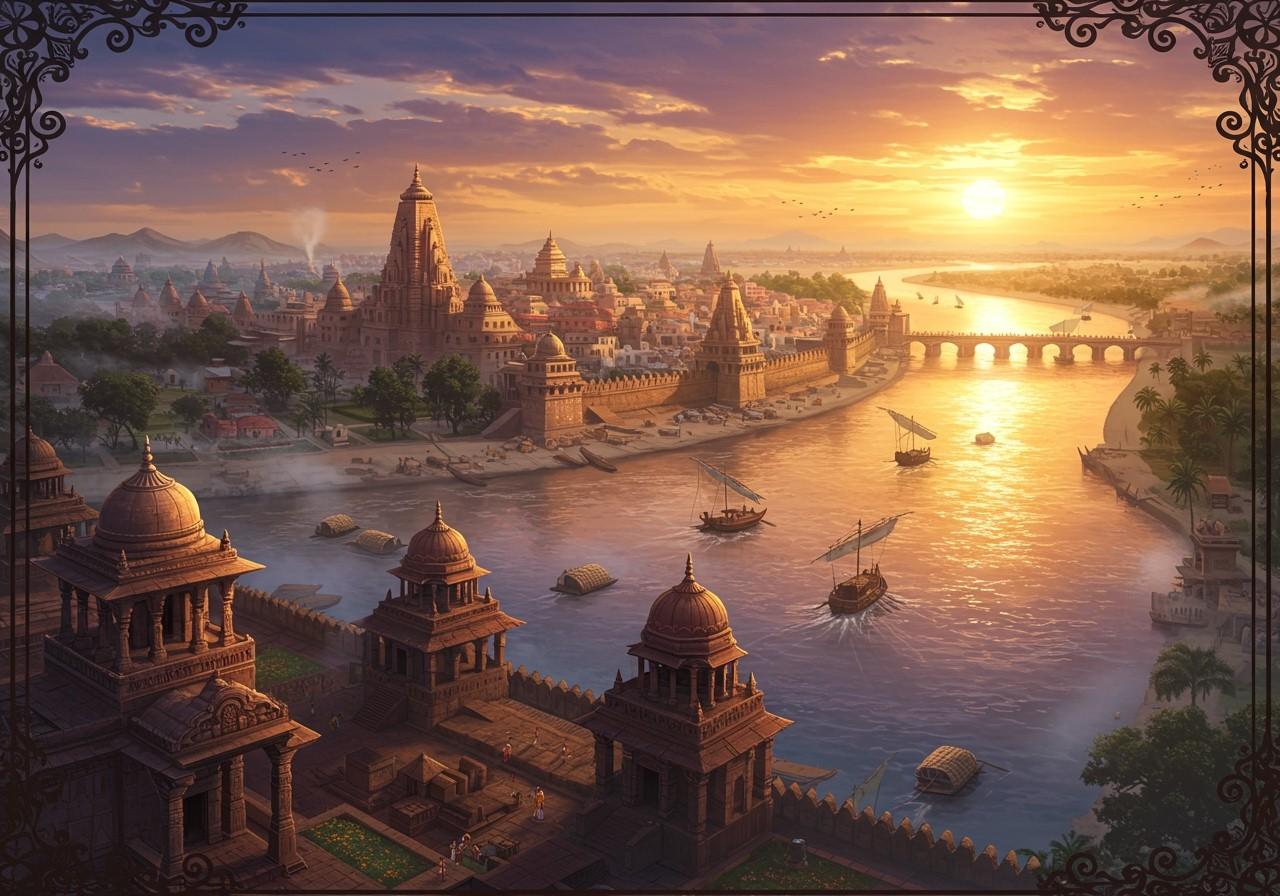
Pataliputra, adjacent to modern-day Patna in Bihar, stands as a testament to the strategic brilliance of its founders in ancient India. Established in 490 BCE by Magadha ruler Ajatashatru, its location at the confluence of the Ganges and Son rivers made it a powerful center for trade, commerce, and political influence. This blog post delves into the historical significance of Pataliputra’s advantageous location and how the Ganges River shaped the empire that thrived there.
Historical Background of Pataliputra
Initially a small fort, Pataliputra’s strategic importance grew over the centuries. It became the capital of the Magadha Empire and flourished under rulers like Chandragupta Maurya and Ashoka the Great, who expanded and fortified the city. During the Mauryan Empire (around 322 to 185 BCE), Pataliputra reached its zenith, experiencing significant advancements in administration, culture, and trade. Even after the decline of the Mauryan dynasty, the city saw a resurgence under the Gupta Empire (approximately 320 to 550 CE).
Pataliputra’s Geographic Location
Situated in present-day Patna, Bihar, Pataliputra’s strategic placement at the confluence of the Ganges, Gandak, and Son rivers offered immense advantages. The fertile plains surrounding the city provided abundant resources for agriculture, while the rivers themselves served as vital arteries for trade and transportation. The Ganges, in particular, played a crucial role in connecting Pataliputra to other parts of India.
The Ganges River: Lifeline of Pataliputra
The Ganges River served as a lifeline for Pataliputra, acting as a major trade route that facilitated the movement of goods, people, and ideas. This bustling waterway fostered economic growth and cultural exchange, connecting Pataliputra with distant regions. The river also supported a thriving agricultural system through irrigation, ensuring food security for the city’s inhabitants. The river’s significance in religious practices further enhanced Pataliputra’s cultural importance.
Economic Impact of Pataliputra’s Location
Pataliputra’s strategic location on the Ganges led to significant economic prosperity. As a major trading hub connecting north and south India, the city saw a vibrant exchange of diverse goods, including textiles, spices, metals, and luxury items. Merchants, craftsmen, and scholars from various regions flocked to Pataliputra, enriching the local economy. Sophisticated taxation and revenue systems were implemented to manage the booming trade and contribute to the city’s wealth.
Cultural and Political Significance
Pataliputra’s strategic location fostered a vibrant cultural landscape. Its position as a center of learning was bolstered by the proximity of renowned institutions like Nalanda. The city’s grandeur was reflected in its architectural marvels, including palaces, stupas, and sprawling gardens. Political stability under the Mauryan and Gupta empires provided a conducive environment for cultural flourishing. The diverse population, encompassing Buddhists, Jains, and Hindus, created a rich tapestry of religious and philosophical thought.
Decline and Legacy of Pataliputra
Following the decline of the Gupta Empire, Pataliputra experienced a period of decline. Invasions, such as those by the Huns in the 5th century CE, significantly weakened the city. Internal strife and administrative challenges further contributed to its downfall. Despite this decline, Pataliputra’s legacy endures. Archaeological findings, including remnants of palaces, monasteries, and fortifications, provide glimpses into its glorious past and offer valuable insights into ancient urban planning, architecture, and the rich cultural heritage of the region.
Modern-day Patna: The Enduring Legacy
Today, modern-day Patna stands on the grounds of ancient Pataliputra. The city’s strategic location continues to be relevant, with the fertile plains and rivers supporting agriculture and trade. Patna remains an important city in Bihar, a testament to the enduring legacy of Pataliputra. Its history serves as a reminder of the rich traditions and cultural significance of this ancient city.
How Poojn.in Connects You with Pataliputra’s Heritage
Poojn.in, India’s leading provider of spiritual and cultural goods, offers a unique opportunity to connect with the rich heritage of Pataliputra. We offer a wide selection of authentic puja items and ritual materials, allowing you to experience the traditions that were once practiced in this historic city on the banks of the Ganges.
- Gangajal (Holy water from the Ganges): Directly sourced from the sacred river that played such a vital role in Pataliputra’s history, our Gangajal is available for your spiritual practices.
- Traditional brass and copper items: We offer a beautiful collection of traditional brass and copper puja items, reminiscent of the craftsmanship that flourished in ancient Pataliputra.
- Puja thalis and accessories: Find everything you need for your puja ceremonies, carefully curated to honor the traditions of the region.
- Ritual items for various ceremonies: Explore a wide array of ritual items for various ceremonies, helping you connect with the spiritual heritage of Pataliputra.
With Poojn.in’s convenient online shopping and nationwide delivery, including to modern-day Patna, you can easily access these authentic items. Download our mobile app for an even more seamless shopping experience. Visit Poojn.in today and discover the rich heritage of Pataliputra.
Explore our collection of Sakha by Poojn, Paita by Ashim Banerjee, Maa Lakshmi Murti, Pure Aguru by Balaji, Jati Kapali Ghata, Maha Tirtha Gold Sindoor, Paddy Seeds for Puja, Chand Mala, Mangalam Camphor Powder, Cotton Thread and Kala Til to enhance your spiritual journey.
Learn more about India’s rich spiritual heritage through our blog posts: Prayagraj: A Journey Through Faith and Culture, Tulsi Peeth Resources: Your Guide to Spiritual Growth, Connecting with the Divine: The Essential Role of Spiritual Guides, India’s Festivals: A Celebration of Culture and Spirituality, Ganges River: Spiritual Significance Explained, and Tulsi Peeth Acharya Ramchandra Das and His Enduring Influence.


